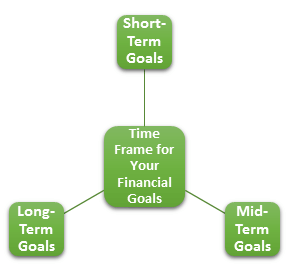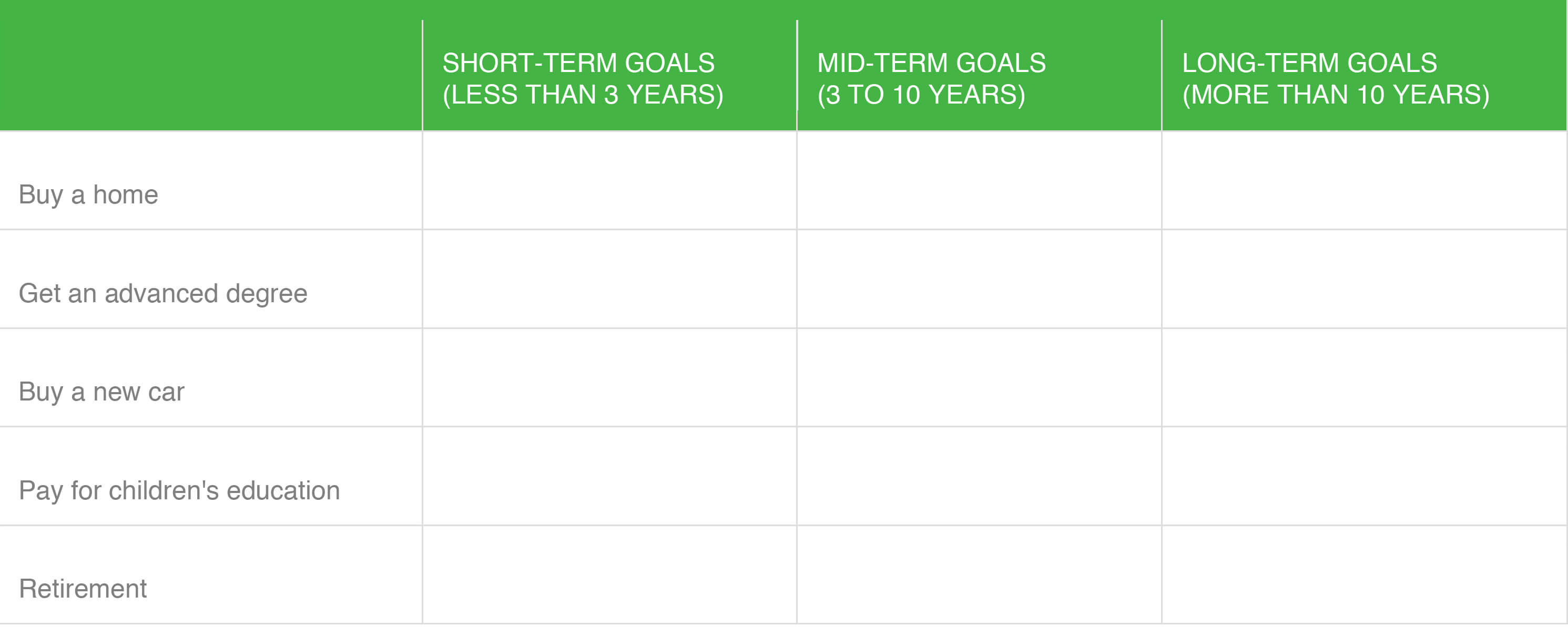It’s important to know the “when” of your financial goals, because investing for short-term goals differs from investing for long-term goals: Your investment strategy will vary depending on how long you can keep your money invested. Most goals fit into one of the three categories below:

SHORT -TERM GOALS (LESS THAN THREE YEARS)
The closer you get to your goal, the less risk you generally want to take with the money you’ve already accumulated to pay for it.
Because you plan to spend the money you set aside for short-term goals relatively quickly, you’ll want to focus on safety and liquidity rather than growth in your short-term portfolio.
This means you’ll be more inclined to put your money into government insured Treasury Bills, term deposits or CD’s, which aren’t likely to lose much value in six months or a year. Liquid investments are those you can sell easily with little or no loss of value, such as Treasury bills, money market accounts and funds, and other low-risk investments that pay interest. If those investments have maturity dates, the terms are very short. For example, T-bills have maturity dates of 13 or 26 weeks.
You may also want to consider alternatives that don’t impose potential penalties or fees for accessing your money before a maturity date. For example, a five-year CD might be safe, but the early withdrawal penalty is likely to cut into the money you are counting on for a short-term goal such as a down payment on a home you want to buy next year or a tuition payment that’s due next October.
Cash investments typically pay lower interest rates than longer-term bonds—sometimes not enough to outpace inflation over the long term. But since you plan to use the money relatively quickly, inflation shouldn’t have much of an impact on your purchasing power.
![]()
MID -TERM GOALS (THREE TO TEN YEARS)
Choosing the right investments for mid-term goals can be more complex than choosing them for short- or long-term goals. That’s because you need to strike an effective balance between protecting the assets you’ve worked hard to accumulate while achieving the growth that can help you build your assets and offset inflation.
Mid-term goals are typically those for which you need time to accumulate the money. Or they may be things you’re not yet ready for but are looking forward to. The more time you have, or the more flexible the timing, the more risk you can probably afford to take with your money.
For example, you might want to invest some of your assets in stocks, either directly or through mutual funds or exchange-traded funds, because of the potential for a higher return that would allow you to reach your goals sooner. As the time frame for those goals gets shorter, you can gradually move some of those assets into more price-stable investments.
Here are possible strategies for managing a portfolio of investments for goals that are three to ten years in the future:
> Balance your mid-term portfolio with a mix of high-quality fixed-income investments—such as a mid-term government bond fund or high-yield CD—with modest growth investments, such as a diversified large-company stock fund. Then monitor the stock investments closely and be prepared to sell to limit your losses if there’s a major market downturn.
> Establish limits for gains and losses in your mid-term stock portfolio. For instance, you may decide ahead of time that you’ll sell an investment if it increases in value 20 percent or decreases 15 percent—or whatever percentage you’re comfortable with. As your goal approaches, you can reinvest your assets in less volatile investments.
> Balanced funds, which usually invest in a mix of about 60 percent stock to 40 percent bonds, growth and income funds, or equity income funds that invest in well-established companies that pay high dividends, might be appropriate choices for a mid-term portfolio. Ultimately, the key to achieving modest growth while minimizing risk is to keep a close eye on performance and gradually shift to more stable, income-producing investments as the date of your goal approaches.
![]()
LONG -TERM GOALS (MORE THAN TEN YEARS)
For many people, the number one long-term goal is a financially secure retirement. But it’s also a goal with a long time horizon. When your goal is paying for college, for example, you think in terms of paying costs for four years—or perhaps a few more for a post-graduate or professional degree. But when you think about retirement, you have to think in terms of managing expenses for 15, 20, 30, or maybe even 40 years that you’ll be living after retirement.
Since you’ll need income for that entire period, it is important to make your money work for you, and this means earning a rate of return that outpaces inflation and allows your principal investment to grow over time.
The general rule is that the more time you have to reach a financial goal, the more investment risk you can afford to take.
For many investors, that can mean allocating most of the principal you set aside for long-term goals to growth investments, such as individual stock, stock mutual funds, and stock exchange traded funds (ETFs). Over time, you can gradually shift a greater percentage of your accumulated account value into income-producing investments such as bonds.
While past performance is no guarantee of future results, historical returns consistently show that a well-diversified stock portfolio can be the most rewarding over the long term. It’s true that over shorter periods—say less than 10 years—investing heavily in stock can lead to portfolio volatility and even to losses. But when you have 15 years or more to meet your goals, you have a good chance of being able to ride out market downturns and watch short-term losses eventually be offset by future gains.
In addition, some investors successfully build the value of their long-term portfolios buying and selling bonds to take advantage of increases in market value that may result from investor demand. Others diversify into real estate. The larger your portfolio and the more comfortable you are making investment decisions, the more flexible you can be. As you begin thinking seriously about what your goals are, you’ll want to be specific about your time frame for meeting them.
You may find it helpful to put your ideas down in writing, perhaps in a chart form like this:

Keep in mind that no goal is short-, medium-, or long-term forever, and so the timetable for your financial goals will evolve over time. For instance, retirement will be a long-term goal when you’re 35, but will probably be a short-term goal when you’re 65. Similarly, paying for your child’s higher education will be a long-term goal when she’s a baby, but a short-term goal when she’s a high-school sophomore. Your investing approach—and choice of investments—will need to evolve as you draw closer to each of your goals.
As your priorities or life circumstances change, you may also find that you want to delay certain goals by a year or two, while others you may want to try to meet sooner. And some—such as a second car that you were planning to buy or an expensive family trip—you may decide to forego altogether. It’s important to stay flexible and adapt your timetable to your changing needs and priorities.
